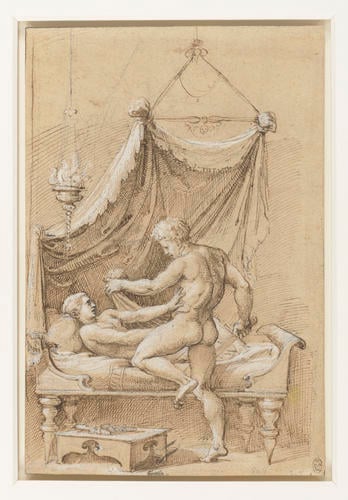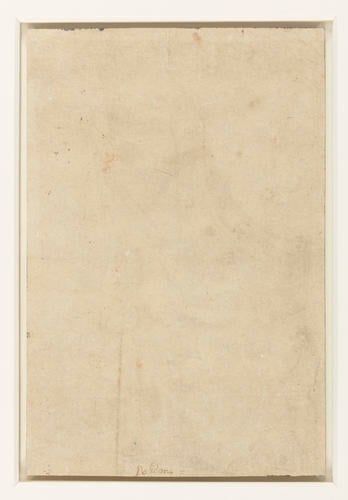-
1 of 253523 objects
The Rape of Lucretia c.1520-3
Pen and ink with white bodycolour, over black chalk on paper washed buff | 24.9 x 16.7 cm (sheet of paper) | RCIN 990506

Attributed to Giovanni Francesco Penni (1496-c. 1536)
The Rape of Lucretia c.1520-3

Attributed to Giovanni Francesco Penni (1496-c. 1536)
The Rape of Lucretia c.1520-3


-
In an episode from the legendary history of ancient Rome (recounted in eg. Ovid, Fasti, II, 725-852), the noblewoman Lucretia was raped by Sextus Tarquinius, son of the tyrant Lucius Tarquinius Superbus. After writing to her husband and father, Lucretia took her own life, and the ensuing outcry led to a rebellion in which Lucius Tarquinius was deposed and he and his family exiled from Rome, so beginning the Roman Republic in 509 BCE.
This drawing largely corresponds to the left-hand portion of an engraving by Agostino Veneziano, inscribed RAPHAE. URB. INVEN. and dated 1524 (RCIN 852202; Bartsch XIV, p.169, no. 208; the plate was later reworked by Enea Vico, 852203, Bartsch XV, p.287, no. 15). Bartsch described an earlier state dated 1523, though no impressions have been located. There are enough differences between drawing and engraving, in particular in the form of the bed-hanging, to establish that the drawing is not a copy from the print.
An inscription on the print crediting the invention to Raphael is plausible in the figure group. Although there is nothing in his surviving work that connects directly with the composition or poses, the mood of elegant violence is that of several of his compositions, such as the late Stoning of St Stephen, modified and painted by Giulio Romano after Raphael’s death (see RCIN 990339). The old ascriptions of the present drawing to Raphael or Polidoro, repeated in the nineteenth century, have given way in recent decades to a generally accepted attribution to Gianfrancesco Penni. The sheet must be by the same hand and of the same date as several similarly worked drawings of the early 1520s, such as the Jonah (RCIN 990804 – see that entry for a discussion of the attribution and the other related sheets), many of which are probably adaptations of designs by Raphael after the master's death. Bartsch's reported first state of the print provides a latest possible date of 1523 for the drawing.
Inscribed lower right, pencil, Raffael; lower left, pen and ink, R[a]ff[ae]l, cut. On the verso is the inscription Polidor followed by, in another hand, 4.3., the price code used by the dealer William Gibson (1644-1702). The Polidor is not in Gibson’s hand, and it thus seems likely that Gibson simply added his price-mark to a pre-existing ascription, rather than duplicating the artist's name.Provenance
William Gibson (1644-1702); probably acquired by Charles II. Not identified in George III's 'Inventory A' of c.1810.
-
Creator(s)
Acquirer(s)
-
Medium and techniques
Pen and ink with white bodycolour, over black chalk on paper washed buff
Measurements
24.9 x 16.7 cm (sheet of paper)
Object type(s)
Other number(s)
RL O : Royal Library "O" Number Register – RL O506Alternative title(s)
Tarquin and Lucretia